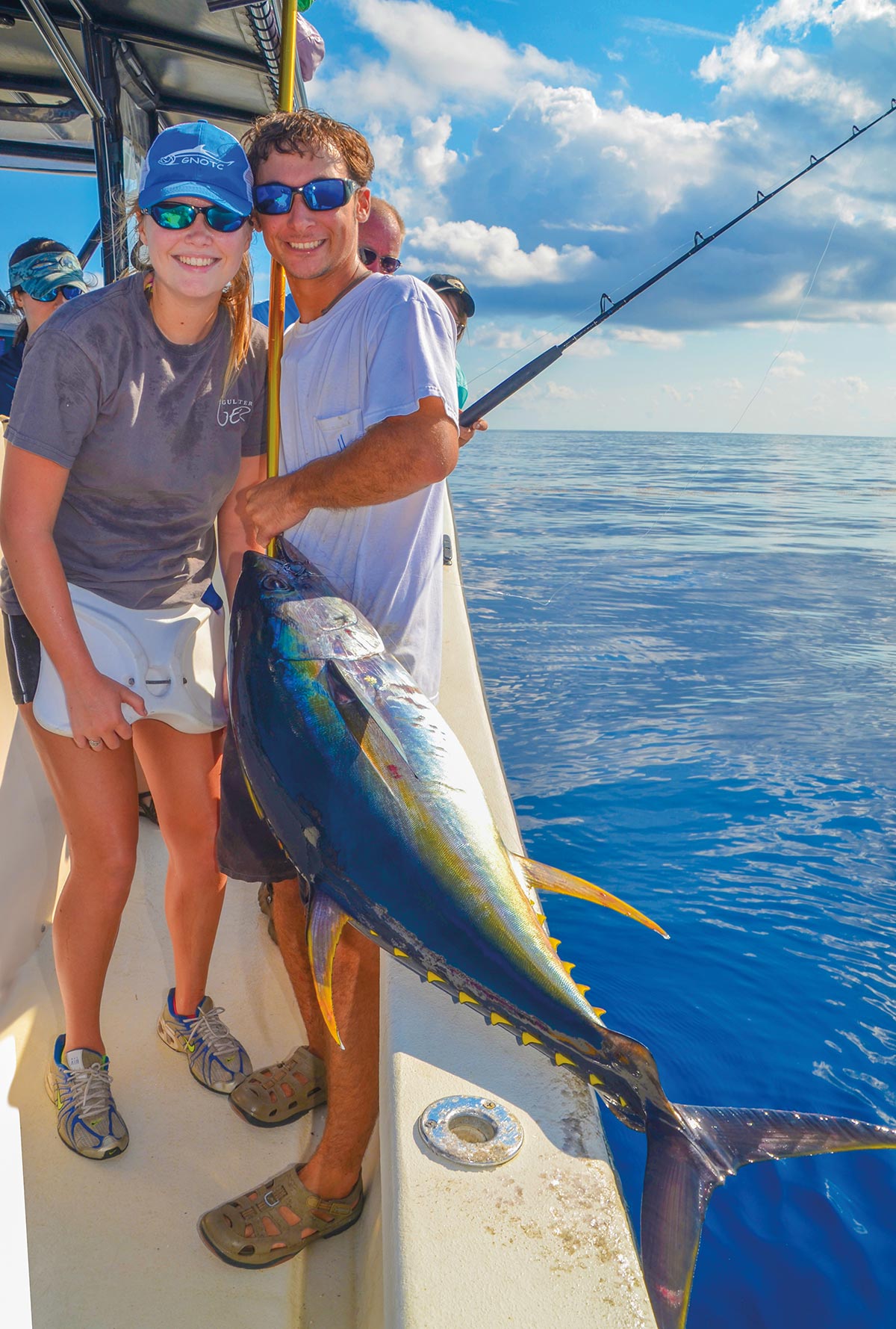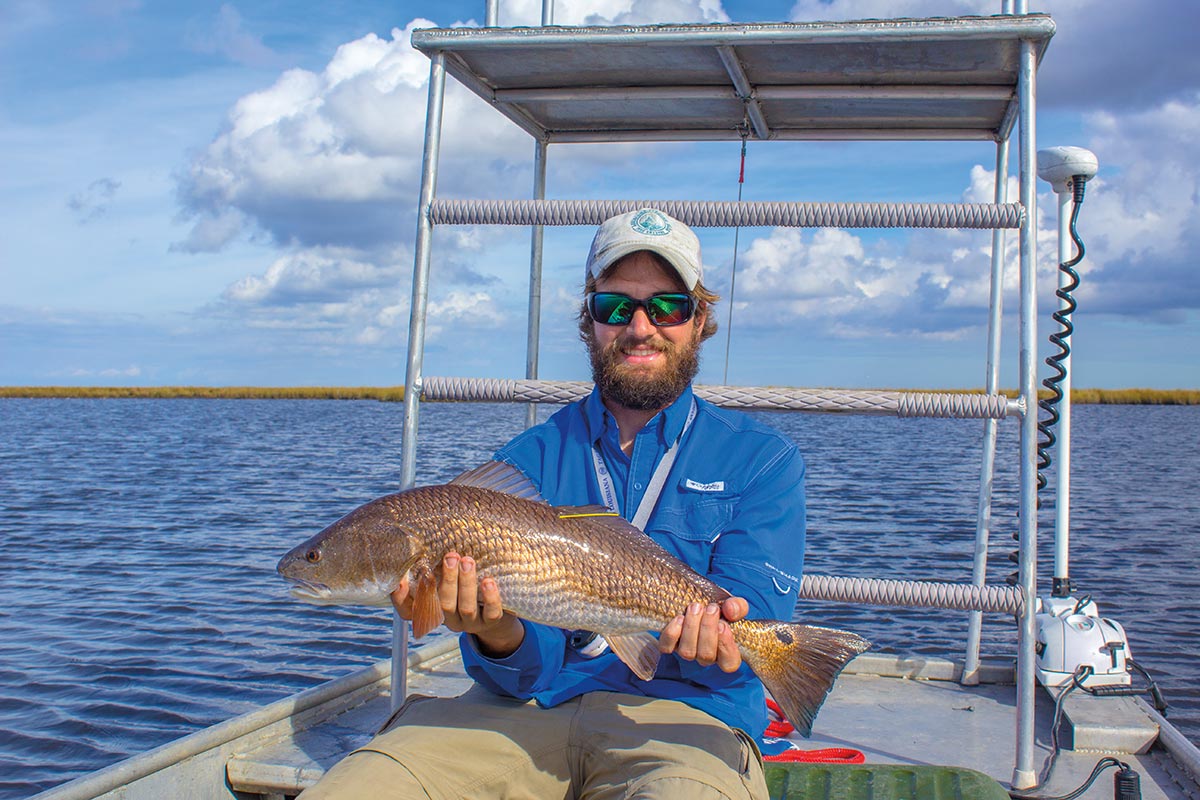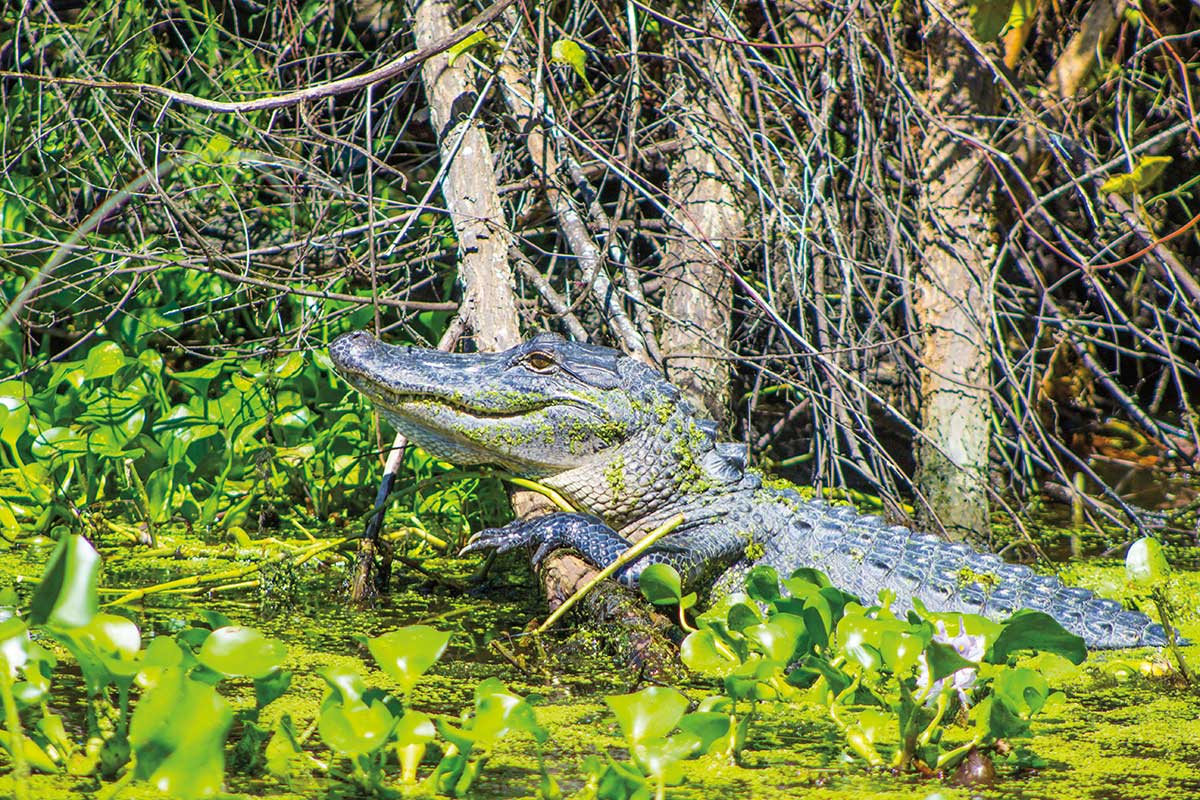
BY CAPT. DEVIN DENMAN
The boat moved down the bayou and I could hear the sound of water rushing around the hull. The four-stroke motor worked quietly, and I took a look backwards to see if anyone was trailing me. All was clear. It was a warm, summer morning and the sun wasn’t over the horizon yet, but I could see orange and yellow rays making their way through the cypress trees. Nobody knows Louisiana for her sunrises, I thought to myself. I finally cleared the swamp, leaving tall cypress trees laden in Spanish moss behind me, and entered a freshwater marsh. Onward the boat pressed, for I had a long trip ahead of me. I was exploring a new part of Louisiana to fish. Despite spending my life fishing her vast estuary, I had not yet seen it all and today was the day to check off one more area. As I trekked further south, the salinity rose, crab traps appeared, saw grass was replaced by spartina grass and I could see PVC poles marking oyster leases. I knew I was finally where I wanted to be. Today, I was scouting for redfish, otherwise I had just run over miles of great fishing for bass, sacalait, catfish and more.

Louisiana, well known as a redfish and inshore fishing haven, also supports a prolific tuna fishery offshore.
Photo: Capt. Devin Denman.
I took the boat off-plane to assess my surroundings and look for good redfish ponds to sight fish. We have the best sight fishing in the world and nobody knows it. Indeed, there were no other boats in sight. The only sign of human life was my wake fading away across glass-calm water.
I looked up from the GPS and took a moment to appreciate the vista. The sun was over the horizon, shining through a mass of clouds that diffused her light into a spectrum of color. I looked over the marsh, knowing there was more over the horizon and more past that before there was the Gulf of Mexico. I looked behind me, where I came from, knowing that is where the mighty Mississippi once flowed eons ago, building this land mass and abundant fishery.
I picked out a spot only a few hundred yards away where I killed the outboard, dropped the trolling motor and climbed in the sighting platform. The sun was just high enough I could see into the crystal clear water. There she was, what I came looking for: a gorgeous, golden, bronze beauty of a redfish.
I remember that fishing trip like it was yesterday. I launched out of Westwego and made my way down Bayou Segnette to fish the area around Lafitte. In fact, you can run from the freshwater swamp 20 minutes from Bourbon Street all the way down to Grand Isle on the Gulf Coast. The run is about 50 miles. There is a lot of prime fishing real estate and it’s not the only part of Louisiana that is so vast. There is the Biloxi Marsh, Cocodrie, Delacroix and a whole bunch more. With such expansive, aquatic real estate, it should come as no surprise that “Sportsman’s Paradise” has long been the tagline on Louisiana license plates.
More Means More
There is a joke where I am from. When people visit from out of town and want to go fishing we tell them that we do not go fishing. Confused expressions are usually passed around the room before they predictably ask, “Well, what do you do?” We always reply, “We go catching.” Like any good joke, what makes it funny is that it’s largely true.
Louisiana has excellent freshwater, inshore and offshore fishing, for everything from largemouth bass to yellowfin tuna. Not only do we have a variety of angling, but we also yield generous creel limits. When people think of inshore saltwater fishing, they think of Florida. They may envision beautiful, bikini-clad women working a salty, green flat, casting a fly for an elusive redfish. Florida is pretty and looks great on a magazine cover, but if those same women came to Louisiana and mistakenly wore a bikini, they would be carried off by an air force of mosquitoes, gnats and deer flies. However, if they covered up and embraced the less-than-sexy appeal of the Louisiana marsh, they would have a blast catching and releasing the most redfish and speckled trout they’d ever caught in their lives.
To illustrate this point, in Florida, the creel limit for speckled trout is 4–6 per person each day, depending on what zone you are in. In Louisiana, the limit is 25 per person each day. Years ago, when I once operated an inshore fishing charter, I promised a two-fish guarantee and I was not the only guide to do so. Not too many places in the world can do that. Even though the limit has been 25 speck for years, the fishery remains prolific.
Our freshwater fishing is also top notch, with people bringing in a daily creel limit of 10 largemouth bass per angler each day. Slot sizes vary throughout the state, but that didn’t keep Kevin VanDam from winning the Bassmaster Classic in 2011. He pulled 69 pounds and 11 ounces from the waters of Lake Cataouatche, the heaviest five-fish catch of the Bassmaster Classic. He left Louisiana remarking about its incredible estuary, calling it the “best fishery in North America” and that he had “never seen anything like Lake Cataouatche.”
Freshwater fishing in Louisiana holds more than great creel limits of bass; it also holds excellent fishing for other species like sacalait and catfish. The creel limit for sacalait, better known outside of Louisiana as crappie, is 50 per angler each day. In case you didn’t know, sacalait is a French phrase, “sac a last,” or “bag of milk” when translated to English.
Charter captain Tanner Persac of TradeWinds Marina and Lodge in Cocodrie, Louisiana, pulls in a red snapper caught near an oil rig in the Gulf of Mexico. Photo: Tim Mueller.
Perhaps you have heard of KVD cleaning house in the Bassmaster Classic or our awesome inshore fishing, but if there is one thing Louisiana is never pegged for is her offshore action. Yet the boot-shaped state is home to some of the nation’s best offshore fishing and is a world class tuna destination.
It’s not uncommon to load the boat down with blacken tuna, catching as many as 20 blacken in a night. Yellowfin tuna are considered more difficult to land, but avid offshore anglers routinely bring back four to six yellowfin each trip. Louisiana is also blessed with great catches of various species of grouper and snapper, mani mani and even blue marlin.
Gumbo Anyone?
So why is Louisiana fishing so rich? Like a good gumbo, it takes just the right ingredients. First, Louisiana’s wetlands are expansive, making up approximately 41 percent of the nation’s coastal wetlands (that’s right, nearly half the coastal wetlands in the entire U.S.). This entire area varies in habitat. Some areas are swamp laden with live oaks while other regions are defined by prairie marsh with brackish water flowing through with the tide. The real key is understanding how it all got there in the first place.
These swamps and marshes didn’t grow by accident; they were put there by the Mississippi River. If you look closely at a map of Louisiana, you will see many bayous that run straight, long and true. These bayous originated from the river and have names like Bayou LaLoutre, Bayou Terre aux Beouf and Bayou Lafourche. These bodies of water are where the river once flowed, eons ago, building up a land mass on each side of her mouth.
The Mississippi is often called “Big Muddy” because of the sediment load she carries in her current. This load of dirt is taken from other parts of the North American continent, suspended in her waters and transported downstream toward the Gulf of Mexico. It is there that the current slows down and the sediment comes out of suspension and settles on the bottom of the water column, creating land mass. In turn, habitat for a variety of marine species is formed. It is not difficult to imagine this giant of a river having so much sediment to build vast tracts of land when you realize she drains water from as far east as New York to as far west as Montana. The confluence between nutrient-rich river water and high salinity salt water is a dynamite combination.
The resulting wetlands create a productive nursery for all kinds of marine denizens.

Capt. Denman sports a nice redfish. Louisiana’s vast inshore habitat allows for high creel limits, typically up to 25 specks per day.
Photo by: Capt Devin Denman.
Another key ingredient in Louisiana fishing is the oil and gas industry, which has a huge presence in the state. I’m pretty sure we became famous for it in April 2010 with the BP oil spill. The images we all saw of that disaster were chilling, to say the least. It is something that needs to never happen again, but what a lot of people don’t know about the oil and gas industry is how great it has been for the marine environment in the Pelican State. Are you shocked? Let me explain.
In the swamp, you have a lot of benthic structure, or any kind of structure that rises from the bottom of the water column toward the top. In a nutshell, this creates habitat for marine life. Some examples include fallen logs and hydrilla grass. In the saltwater marsh, there is little to no benthic structure. At best, you have oyster beds that rise no more than a few feet above the surrounding sea floor. The Gulf of Mexico is even worse, sporting a flat and featureless bottom
with few domes and canyons to break the current and provide a habitat that will hold fish.
Yet, in recent history there has been a change in this trend. Louisiana’s booming oil industry of the 20th century built oil and gas platforms that dot her wetlands. The steel legs of these man-made structures extend through the entirety of the water column, a phenomenon not found naturally in Louisiana. In turn, things like aquatic grass, barnacles, oysters, clams and coral can grow on these surfaces. From there, the rest of the food chain stacks, creating a significant contribution to the surrounding environment.


The marsh is full of life, from gators to the ubiquitous redfish. The latter are less sensitive to water temperature changes and can be targeted all year.
Photo by: Capt Devin Denman.
Finally, Louisiana has also been active in managing its aquatic resources, both in monitoring the health of the fishery and integrating recreational anglers into that effort. Just one example of this is a cooperative marine tagging program called TAG Louisiana enlists the aid of inshore anglers looking to become citizen scientists. An angler can enroll in the program, receive a tagging kit and begin tagging speckled trout, redfish and more to help marine biologists track their movements and growth rates. It is a program I participate in, and since it is cooperative, I get to see how my fish have grown and traveled whenever they are recaptured.
In fact, the redfish I saw on that morning is out there swimming right now. She was oriented away from me, unable to see the boat when I made a cast beyond her, then retrieved the bait across her field of view. Moments later, she was in the boat, protesting as I took her measurements, inserted a tag into her back and released her in great condition. She made that glorious Louisiana sunrise that much better and, if you come to our awesome fishery, there is a chance you can catch her, too.